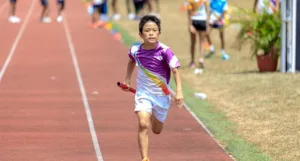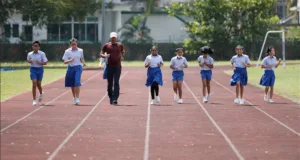What is Stress?
Stress is an ailment that has become all-pervasive, across all sections and strata of society. It is neither gender-specific nor age-specific. It is not communicable for it is generated by oneself within one’s own system as a response to certain conditions.
Every individual’s stress is unique for situations and responses are unique. However, stress amongst students shows repetitive patterns. Students, increasingly are showing anxiety, fear, anger or aggressiveness, sadness, irritability, frustration, and depression.
A student, unknown to anybody but themself, experiences pressure from various quarters. Whether the student wants it or not they have to fulfill parameters that have been predetermined by the society at large and their elders in particular.
So, we have parental pressure, societal pressure, and peer pressure which combine to form performance pressure. The yardsticks of measuring a student’s worth are the prod and nudge for them to perform.
When, if they are unable to do so brings their self-worth down to zilch. It is the fear of that zilch that converts to stress amongst students.
What is the Difference Between Stress and Pressure?
Stress and Pressure are used interchangeably by us with particular reference to students. But they are as different as chalk from cheese.
According to Hendrie Weisinger, a world-renowned psychologist,” stress refers to the situation of too many demands and not enough resources – time, money, energy – to meet them.
Pressure is a situation in which you perceive that something at stake is dependent on the outcome of your performance.”
Students’ stress might be due to a variety of reasons that might lead to overwhelming feelings of being overloaded. These might be examinations, looming deadlines, returning to study, combining paid work and study, time management, monetary debts, and the list goes on.
But pressure on students involves feelings that are the result of compulsoriness. Targets that have to be fulfilled. The ‘do or die’ type of situation.
For example, pressure on students would be to seek admission to a particular institution. There are no options and the student has to decide which way to land in the chosen school. That is the pressure that a student faces.
But that is their cue to focus on the task and deliver the goods. Stress, on the other hand, can be managed.
What are the Types of Stress?
Stress in students begins at school. A constant bombardment of lessons and assignments/examinations swamps the student, from the very moment they step into the school precincts.
Contrary to the very popular and idyllic picture of student life that it is ‘the best time of life’ stress often turns it into the worst time of life. Stress in a student’s life could be five different types: academic, personal, family, financial, and fear of the future.
1. Academic Stress
The most silent and subtle of all the stressors attacking students is academic stress. It emanates from the classroom. The purpose of the student turns into the cause of their stress. Every academic discipline that they opt for has a syllabus that needs to be completed faithfully.
A certain grade has to be achieved and prerequisites to be fulfilled before they can graduate from high school. For this, examinations need to be written, research papers are to be submitted, and assignments are to be graded by their teachers.
All this is to be done in one discipline; consider it multiplied by three or four to calculate the amount of student stress that has to be borne by an individual.
2. Family Stress
Family stress is both overt and covert. It comes from having knowledge of the family’s expectations of the student. The family hopes and expects to see their scion on top of the class. That is enough to make the student suffer from stress.
As if this was not sufficient they themself want kudos from their family. They want to be acknowledged for having made a name for their family in the field of academic achievements.
Their name should be up there on the plaque in the hall amongst all achievers of past academic years. These goals, self-assigned or family generated are enough to render the student sleepless with stress.
3. Everything Else Stress
Everything else stress can be personal, financial, or fear of the future. Personal or financial could be due to the emotional or financial problems the family is undergoing. The parents are in the middle of a bitter divorce, or it could be straitened financial circumstances, it could be anyone’s serious illness.
All sorts of emotional problems that a student’s family is going through can affect them adversely. Or fear of the future stress can arise, they’ll focus on what comes after school, and what they will do in future once they graduate school.
What Causes Stress for Students?
Data shows that the financial health of a student is directly related to academic performance and graduation rates. Financially strapped students are less likely to perform satisfactorily and might even drop out as compared to students with no financial worries.
Students experience financial stress stemming from the fear of being unable to meet tuition costs and monthly expenses. A large number of students are stressed due to their housing and food insecurity.
Their inability to pay rent, afford utilities, or have to move frequently affects their academic performance. This is not all, the study loan that students take from the bank adds to their stress. The fear of not being able to pay their loan dues too fuels the students’ stress that they suffer.
Student stress might also be of a personal nature; meaning how a student responds to the whole situation of being in school. How much and how quickly can students acclimatize themselves to being an adult with responsibilities decides the level of stress that they suffer from.
Unfriendly classmates, hostile roommates, and intimidating professors, all will contribute to the stress that they already bear due to their introverted or extroverted nature. Demands of an ill-timed relationship could also add to the student’s stress load.
Lastly, there is fear of the future or anticipatory stress that is sufficient to throw a student off course. Uncertainty, instability, and self-doubt aggravate the future stress of students. Heightened anxiety and stress happen when students fear that their future plans could be upended by unforeseen circumstances.
As a consequence, they might not be able to meet the liabilities that they have already incurred or plan to in the near future. They end up totally stressed about increased unemployment, recession, and consequent loss of jobs.
All of this contributes highly to the student’s stress and affects their academic performance.
What are the Symptoms of Stress for Students?
In short, student stress is greater now than in past generations. The need to look perfect/great, the driving need to deliver grades, the necessity of monitoring and navigating ‘frenemies’, the push to perform top grade after school, handling high expectations of parents, having to appear always happy, and the absolute compulsion to garner likes, shares and views all push students over the edge and we see symptoms of stress in a student.
These symptoms of stress may be:
Withdrawal from loved ones and acquaintances. The stressed student withdraws from all social interactions with family and friends in an effort to protect themself or hide the stress that they are experiencing.
1. Emotional Changes
High irritability, lack of patience, increased rude behavior, indecisiveness. This is a syndrome where stress causes the student to vacillate in their decisions or even freeze when it comes to making or taking meaningful decisions.
Irresponsible behavioral pattern. Here the student shows signs of obstinacy and might even abandon whatever they have earlier committed to doing.
2. Psycho-Somatic Disorders
Stress in students manifests itself physically, in the form of stomach aches, lack of sleep, binge eating, constant headaches, and so on.
Use of artificial coping devices. Stress in students can push them to excessive drinking or doping. This happens when they find themselves unable to cope with stress independently and do not want to seek help from friends or family.
3. Changes in Cognitive Behavior
Forgetfulness, low concentration, and carelessness are manifestations of stress in students and affect their academic performance negatively.
Negative approach or pessimism. Here we identify self-doubt and feelings of inadequacy when students not able to cope with myriad demands sink into depression.
Is Stress Good for Students?
Stress can be divided into 2 types. Good (Positive) stress and bad (Negative) stress. These two kinds can be differentiated according to the effects it has on the children.
While positive stress helps strengthen the immune system, better the memory, promotes better learning, and teaches children the skill and importance of decision-making, negative stress can deteriorate the mental, and physical health of the child, affect the academic performance along with other detrimental problems, that may or may not be long-term.
While it is a well-known fact that stress is bad for students, there are times when stress helps them perform better, giving them a boost.
Positive stress (scientifically called “Eustress”) can boost motivation, enhance focus and increase the flow of adrenaline to give them more energy. However, it is very short-term in nature. Eustress can be manifested in instances such as watching a horror movie, going on a first date, preparing for an exam, or making an important life decision such as choosing a stream.
In short, Eustress is experienced when there is no immediate fear or threat that is triggering the child’s heart to race.
Why is Stress Management Important?
Coping with stress management is probably the most important and relevant skill every student must learn before graduating from secondary school in Singapore. Lack of stress coping skills can result in long-term depression, underconfidence, and hyper anxiety in students, which can affect their otherwise bright future.
“Stress” is simply your brain responding to a challenge or threat of any kind by releasing a bunch of hormones into your body, in order to increase the heart rate, and raise the blood pressure. Also called the “Flight or Fight Response” fuels your body and mind to deal with the challenge with energy and sanity.
Stress management exercises help in calming down the student’s sudden rush of hormones that increase stress. “Coping with stress” is simply bringing your body back to its normal state, your heart rate normalizing and your flow of hormones relatively lessen.
However, with the daily challenges and threats we conquer, it is often difficult for the body to put a stop to the fight or flight mechanism, resulting in long-term medical ailments such as high blood pressure, constant headaches, and other life-threatening problems.
Therefore, using stress management techniques, and implementing them in daily life is essential.
Stress Management Techniques for Students
So it is that guiding students to manage stress is the need of the hour. There are techniques to manage stress amongst students. Below are the techniques followed by students of the best international school in Singapore:
1. Organize Yourself
Organizing is the key to managing time. Students are prone to be haphazard in their approach to work. If priorities are identified and set accordingly, then it will considerably ease the burden of work in less time than usual.
2. Get Enough Sleep
Students are known to work late into the night not worrying about what havoc sleep deprivation can do to the mind and body. Getting the required sleep rejuvenates the entire system and restarts the human system with increased vigor and the ability to cope with challenges.
3. Practice Visualization
It is guided imagery and is a technique to manage stress. It instantaneously calms and relaxes the body and mind. It detaches you from what is stressing you as you see yourself performing.
4. Exercise Regularly
Physical exertion causes stress to melt away. Stress causes the human brain to pump cortisol. The prolonged presence of this hormone harms and causes damage to the body. But regular exercise detours the body and has feel-good hormones counteracting the negativities, effectively.
5. Listening to Music
This practice stimulates the human brain to follow musical patterns. These patterns are repetitive and relaxing. They draw your mind away and gradually replace the stress affecting you.
6. Practice a Healthy Diet
Students, more often than not end up ‘grabbing bites’. These bites can be toxic fats or carbohydrates that wreak havoc with digestion. Consequently, a student with a demanding schedule ends up with a whole lot of problems.
So eating regularly to maintain steady and stable glucose levels will greatly help in better academic performance.
Adding omega3 fats, fruits, and green veggies, high-fibre foods to your diet will give you the necessary magnesium, calcium, zinc, iron, and other minerals needed to keep you performing consistently without going off track.
7. Avoid the Use of Caffeine and Dope
Students resort to caffeine or substances to enhance their performance abilities and then end up with nervous disorders. It is advisable therefore to avoid such artificial means.
Instead, one should balance exercise, diet, and sleep regimen to get the maximum out of oneself.
Also Read: 10 Life Skills For Students
How Can Teachers Help with Stress Management?
Students can be helped by teachers to cope with stress. Teachers can guide students to recognize symptoms of stress like increased heart rate, depression, and anger and then do some hand-holding to help them fight it.
Students need an adult, an older person who can be their friend during the latter’s downtime. What better than a teacher. The teacher can become their friend, philosopher, guide, and counselor to the troubled student.
Developing a friendly teacher-student relationship would work wonders for students who might need a little warmth and empathy from an elder to see them through their troubles.
However, there are instances where a teacher becomes the reason for the child’s stress. Children often get distressed due to the strictness of their teachers, or by anticipating the reactions of the teacher to maybe forgetting to complete their homework, or not bringing a particular notebook for the class.
While this is taken lightly by some, it is the worst kind of stress a child can face in his/her school life. It makes them avoid going to school, or bunking classes which spikes another kind of stress- causing a negative stress chain reaction in the end.
To avoid this, below are some ways in which teachers can help students cope with stress, and prevent them to feel anxious in their presence:
1. Building Social Interpersonal Relationships Within the Classroom
The teacher can facilitate this as social connectivity would promote the ‘tend and befriend’ rather than ‘fight and flight’ syndrome. The warmth and relaxed atmosphere thus generated would diffuse the fear and all other stressors that a student might experience in their life.
2. Allow Flexibility
Teachers could allow flexibility in submission dates for assignments and encourage students to make mistakes. Fear of making mistakes is what stresses a student most.
A teacher, by being understanding and patient, has the power to make students rise above all their complexes. So, the fear of making a mistake could be turned on its head and transformed into a teaching tool.
3. Acknowledging Students’ Effort
It encourages a student when the teacher acknowledges their hard work. It gives them the impetus to work more sincerely and faithfully. The happiness that they feel gives them a high and that extra burst of energy takes care of the stress that they might be feeling otherwise.
4. Teaching Concentration
A teacher would really be contributing to managing students’ stress if they could teach them to concentrate on the task at hand rather than hopping from one to another. Concentrating and prioritizing are what need to be taught to the student to save them from unnecessary stress.
5. Be More Tolerant of Individual Needs
All students cannot be treated alike. Every student is unique with individual needs and capabilities. A teacher, when recognizes this, becomes an active help in doing away with student stress load.
For example, if a student requires more time than the rest to complete his/her work and the teacher instead of chiding him/her shows patience and understanding; the student ends up completing task with more energy and vigor.
6. Teach the Students to Revise Before Tests
The teacher could teach the students to break down the portion of the test into keywords and cues. This would greatly reduce the enormity of the portion and consequently the resultant stress.
7. Introduce Humor and Laughter During the Lesson
This practice serves to renew concentration amongst students. Continuous serious learning reduces concentration and increases boredom. But if this is broken with intermittent laughter and humor, introduced by the teacher, then students’ stress is greatly taken care of.
8. Creating Visual Images
By painting mental pictures of students performing and gaining merits, the teacher thus shows confidence in students and encourages them to perform without fear.
Stress amongst students is a worrying factor in the present times and should not be left unaddressed. Ignoring it could lead to dire consequences and an entire generation could suffer from it.
It should be understood by all that transitioning is stressful and students should be proactively helped to overcome this impediment on the road to success.

































